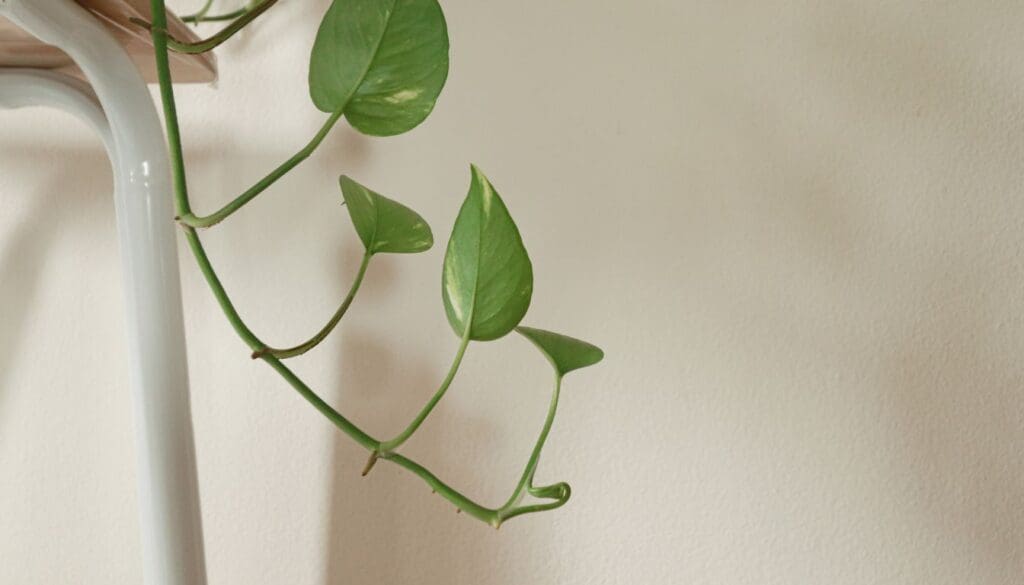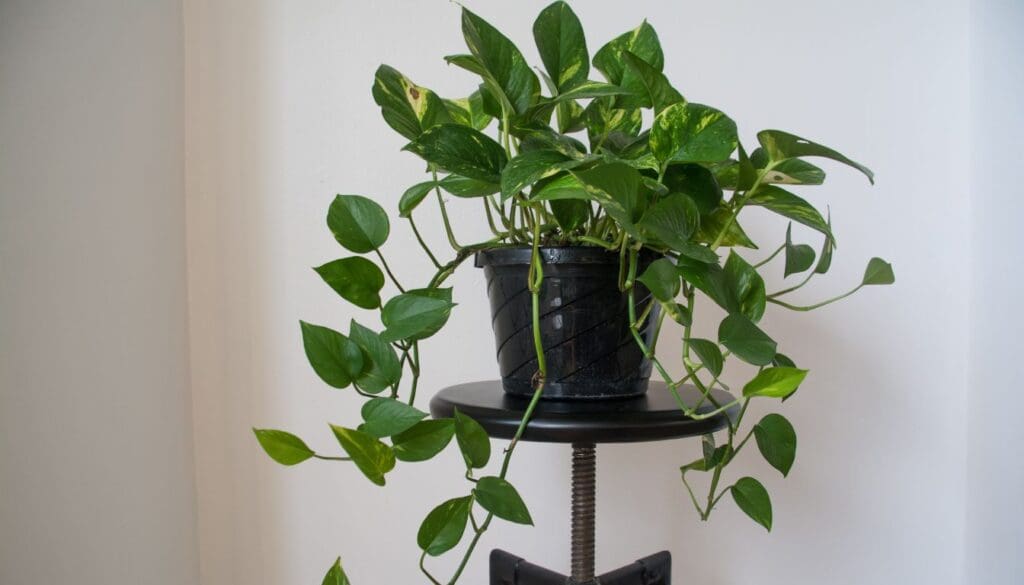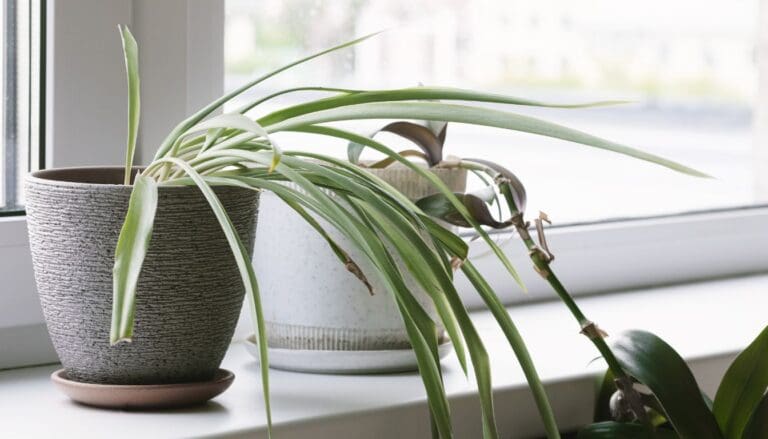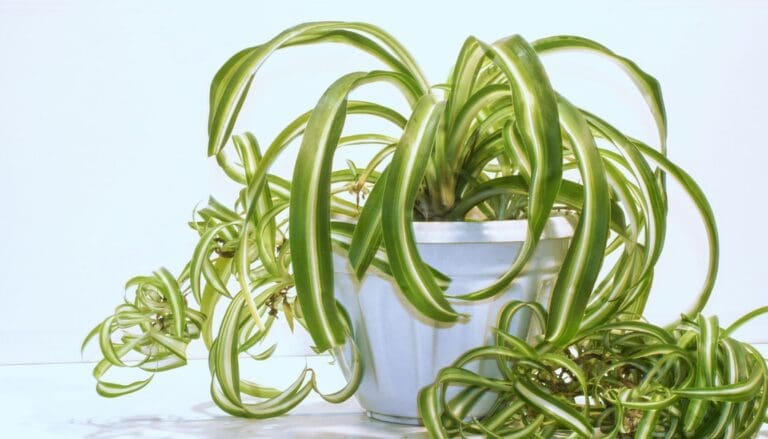9 Common Problems In Pothos Plant: (Fixing Problems+Care Guide)
Pothos have gained popularity for being resilient and low-maintenance plants. But have you ever noticed your Pothos are not doing well? If yes, you are not alone.
Common Pothos issues are leaf discoloration, defoliation, wilting or curling, stunted growth, leggy vines, or a dying Pothos. Finding out what is wrong with your Pothos can be challenging, but essential to provide the correct treatment and help it revive.
Are your Pothos stressed, and you don’t know what’s wrong with it? You have come to the right place. In my 12 years of gardening, I have experienced these issues several times. Today, I will explore the common reasons behind these issues and how to solve them.
Please note: Simplify Plants is reader-supported. Some links in the post are affiliate links and I get a commission from purchases made through links in the post.
Pothos leaves are wilting or drooping

Initial signs of stress in Pothos are often ignored, with wilting being the primary indicator.
Let’s look at the common reasons behind it.
Pothos Watering issues causing wilting and drooping
Pothos love to stay consistently moist.
If you neglect proper watering, your Pothos will wilt due to stress
Overwatering causes roots to suffocate, hindering moisture transfer and resulting in wilting.
Check the soil moisture when you see wilting or drooping in your Pothos.
If the soil feels dry, start watering immediately.
If Pothos repels water due to hard soil, try bottom watering.
If the soil feels moist, stop watering. Let the soil dry out before each watering session.
Pothos Low humidity levels causing wilting
Since Pothos belong to tropical regions, they appreciate 50-60% of humidity.
Dry air causes faster moisture loss from the leaves and makes them wilt.
Adjust the humidity level by misting, installing humidifiers, using a pebble tray method, putting Pothos near aquariums, and approach group planting.
Infestations in Pothos causing wilting
Common pests like aphids, spider mites, and mealybugs suck the plant sap, draw the moisture and nutrients, and make your Pothos wilt out of stress and weakness.
Check your Pothos closely for infestations.
Isolate your plant, spray neem oil, wipe the plant areas with a cotton ball dipped in rubbing alcohol, or use pesticides containing imidacloprid or pyrethrins.
Pothos leaves are turning yellow

Yellow leaves are also typical in Pothos. Below are some common reasons for yellowing:
Pothos leaves are turning yellow due to Incorrect watering or root rot
Besides sunlight, Pothos need adequate moisture and nutrients to photosynthesize and produce chlorophyll.
Overwatering inhibits these functions by suffocating the roots and hindering moisture and nutrient uptake.
Once the roots rot, damaged roots slow down the transfer of moisture and nutrients, increasing yellowing.
Underwatering poses a similar risk, as dehydrated roots struggle to supply nutrients and moisture, causing yellowing.
If you’ve overwatered, cease watering and let the top soil dry out.
For root rot, you will notice brown and mushy stems and roots with yellowing. Repot your Pothos.
For underwatering, water until excess drains out, and consider bottom watering if top watering is ineffective.
Pothos leaves are turning yellow due to Improper sunlight
Pothos can survive in low lights but not darkness.
The leaves cannot produce chlorophyll without enough light, resulting in pale or yellow leaves.
If Pothos is not getting enough light, shift it to a brighter location or use artificial Grow lights.
Pothos leaves are turning yellow due to Pests and diseases
When infested by sap-sucking bugs, Pothos leaves lose their color and vigor because they suck the plant sap, dehydrate the plant and weaken it.
Some fungal diseases like powdery mildew or root rot can also lead to yellow leaves.
Address pests, isolate the plant, use natural predators, apply neem oil, wipe leaves with rubbing alcohol, or use pesticides.
For diseases, isolate and remove the infected parts of Pothos and spray fungicides or hydrogen peroxide.
You can also use homemade fungicides ( 1 part baking soda and 9 parts water).
Pothos leaves are turning yellow due to Poor soil quality
Pothos soil should be well-drained and fertile.
Also, it should be able to hold sufficient moisture needed by Pothos.
When soil has poor drainage, it holds moisture for too long, leading to the same issue as overwatering.
Over time, you’ll notice yellowing.
Add drainage materials without changing the soil, like perlite or vermiculite.
Or, you can replace the entire soil.
An ideal soil mix is 2 parts coco coir or peat, 1 part perlite, and 1 part pine bark fines.
For more, read our Soil article.
Browning in Pothos

If your Pothos have brown leaves or brown spots on the leaves, check out the following reasons:
Browning in Pothos due to Lack of humidity
Pothos require 50-60% humidity indoors.
Leaves lose moisture faster during low humidity, leading to dry, crispy leaves with brown tips and edges.
To adjust the humidity, install humidifiers, use the pebble tray method, keep your Pothos close to aquariums and moss poles, and consider group planting.
Maintain good air circulation around your Pothos while increasing the humidity to avoid infestations.
Browning in Pothos due to Overfertilization
Fertilizing too much can accumulate salts from the fertilizer on the soil surface of the Pothos plants.
These salts reduce the flow of water levels to the roots and limit moisture and nutrient intake by the leaves.
These salts can even burn the roots.
It further creates an osmotic imbalance, where water is drawn out of the plant cells to the soil, causing dehydration and tissue damage.
The leaf tips and edges are the first to show damage signs.
They become brown over time.
Stop feeding your Pothos and observe its condition.
If needed, flush off the soil 2-3 times to remove the accumulated salts.
Browning in Pothos due to Excessive sunlight
Pothos leaves burn and turn brown, starting from the tips and edges, when exposed to the direct sun.
If you notice scorch marks, adjust the lighting by moving your plant 8-9 ft.
away from the window and putting up sheer curtains or Venetian blinds.
You can keep your Pothos near an east-facing window.
It provides gentle sunlight throughout the day.
Browning in Pothos due to Bacterial leaf spot on pothos
Bacterial leaf spots in Pothos appear as brown spots on the leaves.
The disease attacks your Pothos if it is wet or stressed.
To fight the problem, isolate your Pothos, remove the infected parts, stop watering, especially overhead watering, and spray some fungicides.
Pothos leaves are falling off the plant

Sometimes, you will notice that the Pothos leaves are falling off the plant. What could be wrong with it?
Here are some reasons to look at:
Pothos leaves are falling due to Improper watering
Not watering Pothos for too long dehydrates the plant.
As a result, the leaves become dry and crispy and fall off.
Overwatering can also cause the same issue. The leaves wilt, become yellow, and fall off.
Check the Pothos soil and adjust the watering.
If it’s dry, start watering. If it’s wet, stop watering and let the soil dry out.
Also, check for root rot and repot your Pothos if needed.
Pothos leaves are falling Cold temperatures
Pothos love warm temperatures.
Low temperatures below 50-55°F and cold drafts can stress your Pothos.
When leaves become yellow, wilt, and fall off the plant during the fall and winter, cold shock is to be blamed.
To protect your Pothos from cold weather and drafts, consistently keep them in a warmer room with 65-90°F temperatures or use heat mats.
Pothos leaves are falling due to Pests
Sap-sucking bugs like aphids, spider mites, mealybugs, and whiteflies suck the sap and weaken your Pothos.
Weak plants cannot hold too many leaves and hence drop them off.
Isolate your Pothos, spray neem oil, or use chemical insecticides and pesticides containing imidacloprid or pyrethrins.
Note: If your Pothos is healthy and still loses leaves, it is due to aging. These old leaves won’t be replaced by new growth. Prune your Pothos regularly for new and bushy growth.
Slow or stunted growth in Pothos

Except during the winter season, if your Pothos has slow or stunted growth, here are the common reasons:
Stunted growth in Pothos due to Rootbound
When rootbound, Pothos roots grow circularly for more space and bind so tight that roots cannot transfer moisture and nutrients, hence reducing growth.
If roots come out from the drainage holes and soil surface, repot your Pothos to a pot 1-2 inches bigger than the existing one.
Repot your Pothos every 1-2 years during the spring or summer.
Stunted growth in Pothos Nutrient deficiency
Pothos need nutrients to grow at their best.
Lack of nutrients will reduce the plant’s ability to grow and produce new leaves, roots, and vines.
Fertilize your Pothos if you haven’t fed it for years.
Start with a liquid fertilizer for a quick boost and use it every 4-6 weeks during the spring and summer.
Slow growth in your pothos due to Repotting stress
Stunted growth after repotting Pothos is a sign of transplant shock.
It gets shocked by the sudden change and stops growing for some time.
But don’t worry. Keep caring for your Pothos; as it adjusts to the new environment, it will resume its growth rate.
Slow growth due to incorrect soil pH of your pothos
Pothos require pH levels between 6.1-6.8.
Incorrect pH can change soil nutrient levels, impede nutrient absorption, and hinder plant growth.
Add lime to lime to increase the pH and sulfur to reduce it.
Pothos leaves are curling

Are your Pothos leaves curling? What could be wrong with it? Let’s look at the common reasons:
Pothos leaves curling due to Low humidity
Since low humidity increases moisture loss in Pothos, the leaves curl inwards to retain the remaining moisture.
Adjust the humidity by installing humidifiers, using a pebble tray method, keeping Pothos close to aquariums and moss poles, and grouping.
Pothos leaves curling due to Direct sun exposure
Pothos curl away from light when exposed to direct sunlight.
It is a protective mechanism to save themselves from getting burnt.
Adjust the light when Pothos leaves are curling by moving it away from the window and diffusing the light by curtains or blinds.
Pothos leaves curling due to High temperatures
Pothos prefer warm temperatures (65°F-90°F). Above 90°F, the weather gets too hot and dry.
Pothos suffers from repeated dehydration.
To protect themselves, the Pothos leaves curl upwards to retain moisture and adapt to this environment.
Reduce the light exposure and shift your Pothos to a cooler room.
If there is an AC, keep your Pothos 10 ft. away.
Pothos leaves curling due to Pests and diseases
Pothos pests like aphids, spider mites, mealybugs, and whiteflies suck the plant sap and dehydrate it.
As a result, the leaves curl, deform, and drop off.
Bacterial and fungal diseases like root rot, leaf spots, and blights can curl the Pothos leaves and create spots or blotches on them.
Use neem oil, soap sprays, diatomaceous earth, or pesticides for pests.
For diseases, use copper-based fungicides or homemade fungicides made with baking soda and water (1:9) and repot your plant.
Pothos leaves have white spots

Generally, white spots in Pothos are due to the variegation, for example, Snow Queen, Marble Queen, or N’Joy.
But, if the plant looks unhealthy, has white spots, and it’s not a variegated Pothos, below are some common reasons to look at:
Pothos leaves have white spots due to Potassium deficiency
Potassium is an essential macronutrient that encourages Pothos’s growth.
Lack of this nutrient can turn the leaves white.
Make sure your fertilizer contains potassium as the primary macronutrient.
Alternatively, you can add organic matter to improve soil nutrition.
Pothos leaves have white spots due to Powdery mildew
Powdery mildew in Pothos results from high humidity and lack of airflow.
When powdery mildew sets up, the Pothos leaves will have white marks as if powder is scattered.
Spray neem oil or fungicides to treat the issue.
Ensure good air circulation by opening a nearby window, running a fan, and keeping distance between your plants.
Pothos are leggy

There are three common reasons behind a leggy Pothos:
Pothos are leggy due to Lack of sunlight
Pothos can survive under low lights.
However, excessive lowlight conditions make them leggy because the vines constantly try to reach the light source.
Relocate your Pothos to a bright location or use artificial lights, like full-spectrum LED or fluorescent lights.
Pothos are leggy due to Overfertilization
Overfertilizing, especially with nitrogen-rich food, leads to excessive Pothos growth, causing legginess.
Prune the leggy vines, stop feeding, and see how the plant reacts to it. If needed, flush off the soil.
Pothos are leggy due to Climbing nature
Pothos are natural climbers.
If they don’t have any support, their vines keep growing leggy in search of support.
Provide structural support like moss poles or trellis, and prune your Pothos regularly every 2-3 months for compact and bushy growth.
Dying Pothos

What could be wrong if your Pothos is dying? Here are some potential reasons:
Pothos are dying due to Pests
A few pests in Pothos are not concerning as they can be dealt with. A vast infestation can kill your Pothos, especially if you don’t take action initially.
Isolate and remove the infected areas, spray neem or other horticultural oils, use rubbing alcohol solution, or use insecticidal soaps and pesticides.
Pothos are dying due to Diseases
- Pothos diseases like bacterial wilt, powdery mildew, leaf spots, blights, and root rot can kill your Pothos.
- Common signs are:
- Dark spots.
- Distorted and discolored leaves.
- White mold in the soil.
- A foul smell.
Your Pothos will eventually die if infected.
However, you can still help them revive if you notice the signs early and take action.
Here are a few things you can do:
- Isolate your Pothos and remove the infected parts.
- Reduce humidity and let it stay around 60%.
- Increase air circulation and avoid overhead watering.
- Spray some fungicides, either copper-based or homemade.
- For root rot, repot your Pothos in a new pot with a new soil mix.
Pothos care guide

- Provide Pothos with 10-12 hours of bright indirect sunlight.
- Water the plant whenever the top few inches have dried. I water my Pothos every 5-7 days in spring and summer and every 7-15 days in winter.
- Use well-drained fertile soil with 6.1-6.8 pH levels.
- Fertilize your Pothos every 4-6 weeks with a liquid fertilizer and 1-2 times a year with a slow release during the spring and summer. Reduce winter feeding.
- Maintain 65-90°f temperature ranges and 50-60% humidity levels.
- Prune your Pothos regularly every 2-3 months during the active season.
- Repot your Pothos every 1-2 years to provide more room for root growth.
- Check out for pests and diseases and act when you notice the initial signs of distress. Early intervention will keep your Pothos strong.
Final thoughts
Pothos will have multiple problems if you make conditions favorable. However, you can easily solve them by identifying the signs and troubleshooting them.
If you are a beginner in growing Pothos, this guide can help you find out what is wrong with your Pothos and how to solve the issue. I have covered all the possible problems a Pothos plant might face with easy solutions.
Also, follow the essential care tips and cultural practices correctly, to minimize and prevent these issues from occurring and keep it healthy and strong.
What to do with the discolored Pothos leaves?
You can trim them off to increase the appearance of your Pothos. Additionally, it will encourage new growth.
Will the wilted or curled leaves return to normal?
If the wilted and curly Pothos leaves are still green, determine the issue and provide the proper treatment. They will become normal after a few days or weeks.
Reference: Pothos Wikipedia
Recommended Garden Supplies
| Product Image | Our Recommended Gardening Supplies | Check Offers! |
|---|---|---|
Top Top
Top
Top
Top
Top
Top
Top
Top | rePotme Houseplant and Tropical Classic Potting Soil Mix | Check Offer On Amazon |
 Top
Top
Top
Top
Top
Top
Top
Top | Espoma Organic Indoor Plant Food | Check Offer On Amazon |
 Top
Top
Top
Top
Top
Top
Top
Top | GooingTop LED Grow Light 6000K Full Spectrum Clip Plant Growing Lamp | Check Offer On Amazon |
 Top
Top
Top
Top
Top
Top
Top
Top | Soil Moisture Meter | Check Offer On Amazon |
 Top
Top
Top
Top
Top
Top
Top
Top | Govee Hygrometer Thermometer, Bluetooth Enabled! | Check Offer On Amazon |
 Top
Top | LEVOIT Humidifiers for Large Room(Best For Plants) | Check Offer On Amazon |
 Top
Top
Top
Top
Top
Top
Top
Top | Upgraded DIY Automatic Drip Irrigation Kit, 15 Potted Houseplants Support | Check Offer On Amazon |
 Top
Top
Top
Top
Top
Top
Top
Top | Stainless Steel Heavy Duty Gardening Tool Set | Check Offer On Amazon |
 Top
Top
Top
Top
Top
Top
Top
Top | Bonide Insecticidal Soap | Check Offer On Amazon |
 Top
Top
Top
Top
Top
Top
Top
Top | Bonide 32 oz Spray Neem Oil for Organic Gardening | Check Offer On Amazon |
 Top
Top
Top
Top
Top
Top
Top
Top | Garden Safe Fungicide | Check Offer On Amazon |






